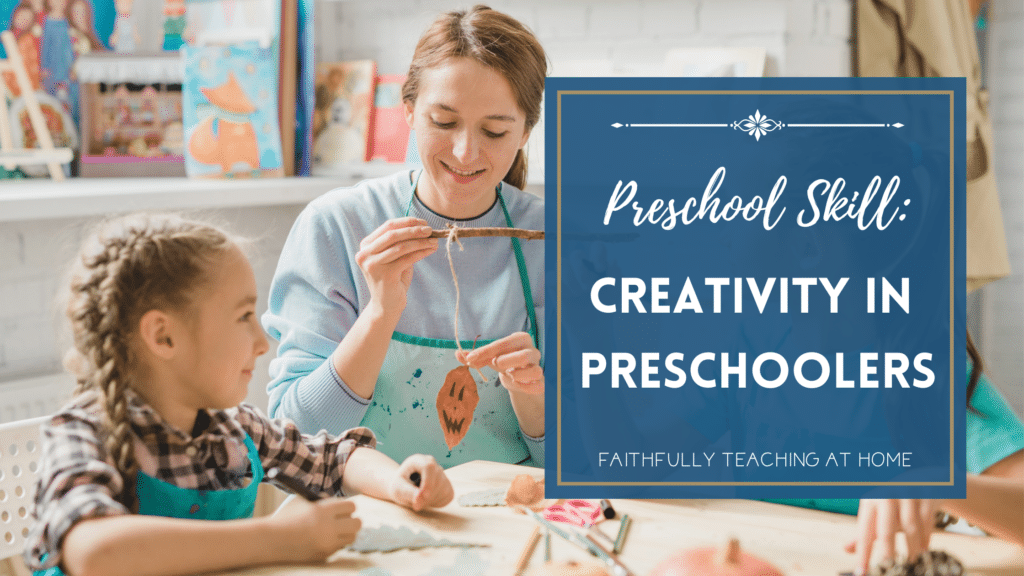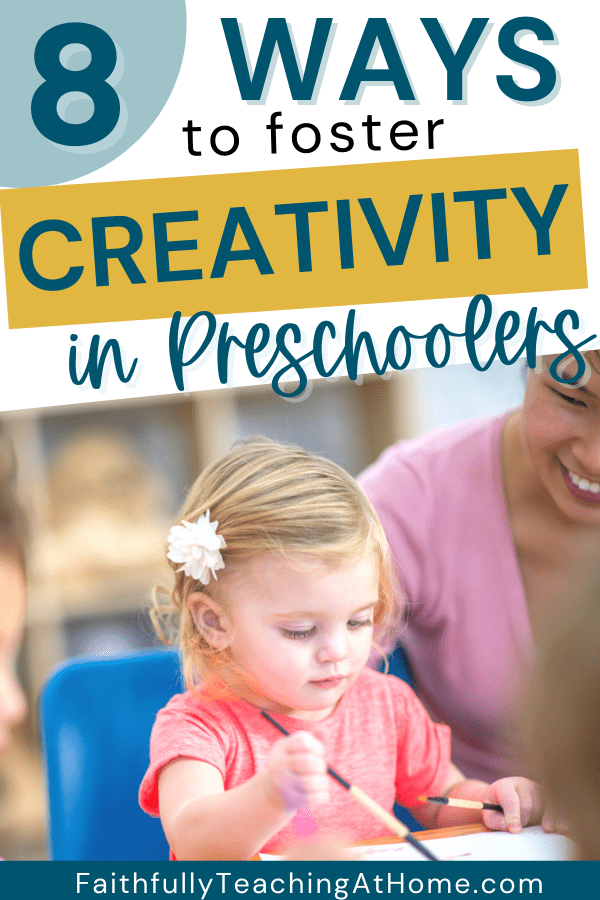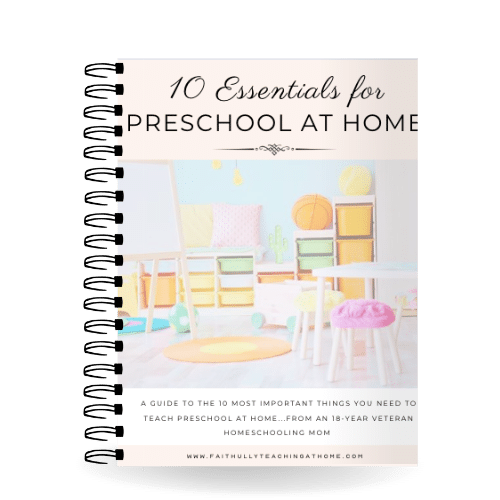8 Ways of Encouraging Creativity in Preschoolers

Encouraging Creativity in Preschoolers
Encouraging creativity in preschoolers doesn’t just mean doing art. In addition to art, creativity can be the way they think outside the box, how they solve problems, and how they play with their toys (or cardboard boxes!). So being intentional about encouraging creativity can help your toddler and preschooler in many ways!
Usually when you hear that someone is “so creative!”, you immediately think of art. You think that they must be an excellent painter or can draw really well. Not everyone can be a highly skilled artist. But everyone can be creative!
Besides art, what subjects can use a good dose of creativity? Science and math are subjects that seem pretty unimaginative. But it takes creativity and curiosity to come up with new formulas, new ways to get a solution, and different hypotheses on why things happen.
All of this to say, encouraging creativity in your child is not a waste of time. They will use it in some fashion at some point down the road. So even if they don’t turn into the next Picasso, keep encouraging creativity in your child!

Why is encouraging creativity important?
We’ve talked a lot about the different ways we can be creative, not just in art. But why is encouraging creativity in preschoolers important? Why not focus solely on academics?
4 Ways Creativity is Important
- Cognitive Development – Cognitive development is the growth of a person’s ability to learn. Creativity enhances that growth by finding new ways to learn, especially since we don’t all learn the same way.
- Imagination – Creativity boosts imagination. Have you ever heard someone say “He has a good imagination.”? A creative imagination can easily be recognizable. And a good imagination leads to innovative thinking, out-of-the-box problems solving, and the ability to test out different social scenarios and language skills.
- Emotional Development – Sometimes art doesn’t turn out the way we want it to, so creativity helps a child to gain confidence to try a different way to get the results he wants.
- Language Skills – Children will practice new words and how to put words together in creative ways during play.

Encouraging creativity in preschoolers
Now that we know why creativity is important, let’s find some ways to put it into action.
8 Ways to Encourage Creativity in Preschoolers
1. Read to Your Child
Reading out loud to your child is the perfect way to build his imagination skills. When you are reading to him, he is picturing what is happening in his head. He will also learn new vocabulary and ways to put sentences together. And did you know he will learn listening skills when you read aloud to him?
2. Control Screen Time
he more your child is watching TV or playing video games, the less time she has to create art and do creative play. Unfortunately, TV and video games don’t do a lot to foster creativity. You can argue that there are aspects to both that can help build some creativity, but those are minor compared to easel painting or playing dress up. I’m not saying to cut out screen time completely at all. Just be mindful of the amount of time they are spending in front of screens.
3. Access to Art Materials
As your child gets to be a preschooler, let him or her have access to art materials daily. I always leave a container out with washable markers, crayons, colored pencils, glue sticks, child safety scissors, and blank paper on a child-size table. Some days I will add other art materials like washable watercolor paints, bingo dauber markers (dot markers), cotton swabs, different colors of construction paper, etc. Swap different materials out every week.
Note: You know your children best. If you have a preschooler that still has a tendency to not use art materials safely or correctly, just bring out the art materials when you are around to monitor their use. Just keep modeling how to correctly them, and soon your child will use them like a champ!
4. Process Art
Focus on process art instead of product art. Have you head the saying “the process is more important than the product”? This is one of those times. Instead of focusing on “cute” art projects with an outcome where everyone’s art ends up looking alike, encourage art like easel painting, finger painting, and collage art where each art piece is unique and different.
5. Let Them Get Messy
Art can be messy. So provide a space where your child can do art without worrying about making a mess. This will help them to relax and be more creative. And it will help you to relax and not be interrupting their time creating masterpieces. You can provide plastic tablecloths, plastic tarp under the table, and smocks to wear over their clothes or old play clothes.
6. Independent Play
Encourage your child to play on his own, without you. This is actually an important skill to learn. Children need to learn how to play on their own. It helps develop imagination, creativity, and self-reliance.
7. Solve Problems
Assist your preschooler in brainstorming on how to solve problems. Be sure to praise her when she comes up with unique and creative solutions! One example on how to do this is when reading a book with her. When the character comes across a problem, have your child brainstorm on different ways the character could solve it.
8. Block Play
This is where kids let their imagination go wild! Make sure you provide lots of different construction-type materials such as wooden blocks in different sizes, Duplos or Legos (depending on age and ability), cardboard blocks, magnetic tiles, etc. Basically any kind of materials that children can creatively construct and use their imaginations. Add mini figures or dolls or plastic animals to add even more fun!

What is Process Art?
As I mentioned above, process art is an excellent way to foster creativity. What exactly is process art? Process art is when the process of making art is the focus instead of the focus being on the outcome. There is no right or wrong way to do it, and (gasp!) there are no samples for them to follow.
For example, easel painting is great example of process art. You provide your preschooler with paint, brushes, and paper and just tell him to paint! If your child isn’t used to this much freedom in art, at first he will keep saying “I don’t know what to paint!”. That’s normal! In the beginning, you can give him simple but vague directions, like “Paint something we saw on vacation” or “Paint something you might see in the ocean”. But after a few times of this, let them think of what to paint on their own. Eventually it will become easier for them, and they will relish the freedom of being creative!
What is Product Art?
Product art is the opposite of process art. Product art is structured with detailed instructions and the desire of a particular outcome. For example, product art is abundant during holidays, especially during Christmas. You show your child a picture of how the craft is supposed to look like in the end. Then you give specific instructions on the steps to take for them to ensure that the craft ends up looking like the picture. In the end, everyone’s finished product looks similar to each other. There’s not a lot of room for encouraging creativity in product art.
NAEYC is the premier national voice for the early childhood education profession. They give excellent examples of the difference of product and process art in this article.
Should I even do product art with my child?
Sure! Product art activities are fun and actually teach children how to follow directions. Children learn the importance of doing things in order. And who doesn’t love getting a Mother’s Day handprint craft with a sweet poem? But just don’t make product art the norm in your homeschool. Give more opportunities for process art and work on encouraging creativity in your homeschool.

Like this poster? I have a pack of 6 different posters that all say “The process is more important than the product” in my TPT store. Click here to see them all!
Put the effort in now and reap results for a lifetime
All of these tips about encouraging creativity in preschoolers may seem overwhelming at first, if you haven’t thought of the importance of creativity before. Take your time and implement one thing at a time. The results will last your child a lifetime!
Want to know what I recommend to teach preschool at home?
Are you thinking of teaching your preschooler at home soon? Not sure what he or she will need to keep up with peers in private preschools? With my background in Early Childhood Education (preK through 3rd), I’ve taught in preschools and even taught preschool to my own 4 children, successfully preparing them for kindergarten while following developmentally appropriate practices. So sign up below to get this FREE 16-page guide to the top 10 essentials that I recommend you need to start teaching preschool while saving hundreds of dollars!







